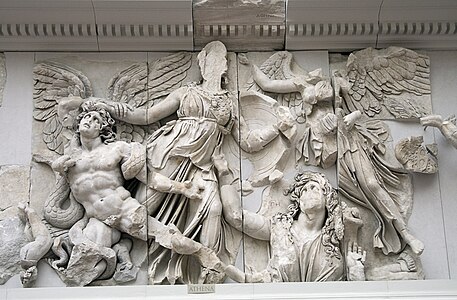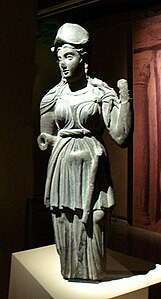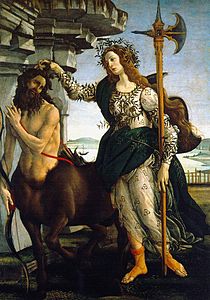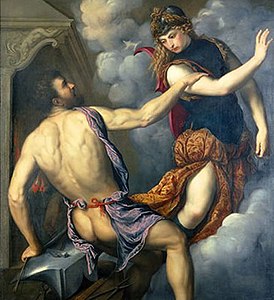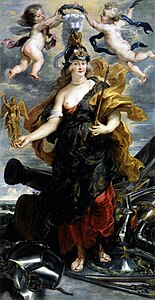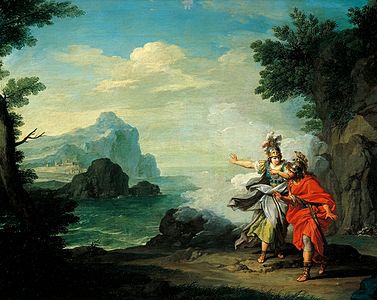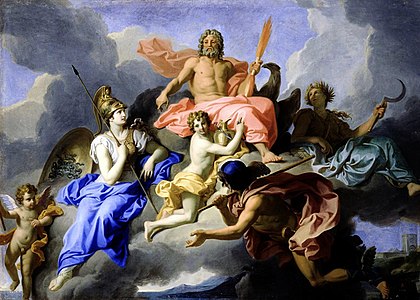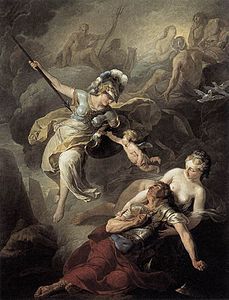Афина
| Афина | |
|---|---|
Богиня мудрости, войны и ремесла. | |
| Член двенадцати олимпийцев | |
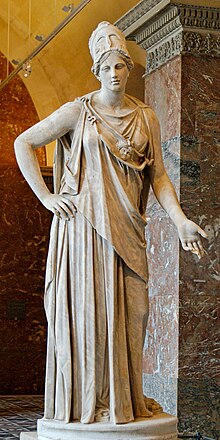 Mattei Athena at Louvre. Roman copy from the 1st century BC/AD after the Greek original Piraeus Athena of the 4th century BC attributed to Cephisodotos or Euphranor. | |
| Abode | Mount Olympus |
| Animals | Owl, serpent, horse |
| Symbol | Aegis, helmet, spear, armor, Gorgoneion, chariot, distaff |
| Tree | Olive |
| Genealogy | |
| Parents | Zeus and Metis[a][1] |
| Siblings | Several paternal half-siblings |
| Children | Erichthonius (adopted) |
| Equivalents | |
| Roman equivalent | Minerva |
| Canaanite equivalent | Anat[2] |
| Egyptian equivalent | Neith |
| Numidian equivalent | Tanit[3] |
Афина [б] или Афина , [с] часто дается эпитет Паллада , [д] — древнегреческая богиня, связанная с мудростью, войной и ремеслом. [4] который позже был синкретизирован с римской богиней Минервой . [5] Афина считалась покровительницей и защитницей различных городов Греции, особенно города Афины , от которого она, скорее всего, получила свое имя. [6] Парфенон Ей на Афинском Акрополе посвящен . Ее основные символы включают совы , оливковые деревья , змей и Горгонейон . В искусстве ее обычно изображают в шлеме и с копьем в руках.
С момента своего происхождения как богиня Эгейского дворца Афина была тесно связана с городом. Она была известна как Полиас и Полиохос (оба произошли от слова polis , что означает «город-государство»), а ее храмы обычно располагались на вершине укрепленного акрополя в центральной части города. Ей посвящен Парфенон на афинском Акрополе, а также множество других храмов и памятников. Как покровительница ремесла и ткачества Афина была известна под именем Эргана . Она также была богиней-воином и, как полагали, вела солдат в битву как Афина Промахос . Ее главным праздником в Афинах была Панафинея , которая отмечалась в середине лета в месяц Гекатомбайон и была самым важным праздником в афинском календаре.
In Greek mythology, Athena was believed to have been born in Lake Tritonis in North Africa (Modern day Algeria and Tunisia) where she is considered native to the land,[7] in this version of the story she is the daughter of Poseidon and Tritonis a Lybian lake nymph, in another version of the story in the same source, they say that she was daughter of Poseidon and Lake Tritonis, and that, being for some reason angry at her father, she gave herself to Zeus, who made her his own daughter, on the other hand some say that she sprang from the forehead of her father Zeus in the same location in north africa.[8] In some versions of the story, Athena has no mother and is born from Zeus' forehead by parthenogenesis. In others, such as Hesiod's Theogony, Zeus swallows his consort Metis, who was pregnant with Athena; in this version, Athena is first born within Zeus and then escapes from his body through his forehead. In the founding myth of Athens, Athena bested Poseidon in a competition over patronage of the city by creating the first olive tree. She was known as Athena Parthenos "Athena the Virgin". In one archaic Attic myth, the god Hephaestus tried and failed to rape her, resulting in Gaia giving birth to Erichthonius, an important Athenian founding hero. Athena was the patron goddess of heroic endeavor; she was believed to have aided the heroes Perseus, Heracles, Bellerophon, and Jason. Along with Aphrodite and Hera, Athena was one of the three goddesses whose feud resulted in the beginning of the Trojan War.
She plays an active role in the Iliad, in which she assists the Achaeans and, in the Odyssey, she is the divine counselor to Odysseus. In the later writings of the Roman poet Ovid, Athena was said to have competed against the mortal Arachne in a weaving competition, afterward transforming Arachne into the first spider; Ovid also describes how Athena transformed her priestess Medusa and the latter's sisters, Stheno and Euryale, into the Gorgons after witnessing the young woman being raped by Poseidon in the goddess's temple. Since the Renaissance, Athena has become an international symbol of wisdom, the arts, and classical learning. Western artists and allegorists have often used Athena as a symbol of freedom and democracy.
Etymology

Athena is associated with the city of Athens.[6][10] The name of the city in ancient Greek is Ἀθῆναι (Athȇnai), a plural toponym, designating the place where—according to myth—she presided over the Athenai, a sisterhood devoted to her worship.[9] In ancient times, scholars argued whether Athena was named after Athens or Athens after Athena.[6] Now scholars generally agree that the goddess takes her name from the city;[6][10] the ending -ene is common in names of locations, but rare for personal names.[6] Testimonies from different cities in ancient Greece attest that similar city goddesses were worshipped in other cities[9] and, like Athena, took their names from the cities where they were worshipped.[9] For example, in Mycenae there was a goddess called Mykene, whose sisterhood was known as Mykenai,[9] whereas at Thebes an analogous deity was called Thebe, and the city was known under the plural form Thebai (or Thebes, in English, where the 's' is the plural formation).[9] The name Athenai is likely of Pre-Greek origin because it contains the presumably Pre-Greek morpheme *-ān-.[11]
In his dialogue Cratylus, the ancient Greek philosopher Plato (428–347 BC) gives some rather imaginative etymologies of Athena's name, based on the theories of the ancient Athenians and his etymological speculations:
That is a graver matter, and there, my friend, the modern interpreters of Homer may, I think, assist in explaining the view of the ancients. Most of these in their explanations of the poet, assert that he meant by Athena "mind" [νοῦς, noũs] and "intelligence" [διάνοια, diánoia], and the maker of names appears to have had a singular notion about her; and indeed calls her by a still higher title, "divine intelligence" [θεοῦ νόησις, theoũ nóēsis], as though he would say: This is she who has the mind of God [ἁ θεονόα, a theonóa]. Perhaps, however, the name Theonoe may mean "she who knows divine things" [τὰ θεῖα νοοῦσα, ta theia noousa] better than others. Nor shall we be far wrong in supposing that the author of it wished to identify this Goddess with moral intelligence [εν έθει νόεσιν, en éthei nóesin], and therefore gave her the name Etheonoe; which, however, either he or his successors have altered into what they thought a nicer form, and called her Athena.
— Plato, Cratylus 407b
Thus, Plato believed that Athena's name was derived from Greek Ἀθεονόα, Atheonóa—which the later Greeks rationalised as from the deity's (θεός, theós) mind (νοῦς, noũs). The second-century AD orator Aelius Aristides attempted to derive natural symbols from the etymological roots of Athena's names to be aether, air, earth, and moon.[12]
Origins

Athena was originally the Aegean goddess of the palace, who presided over household crafts and protected the king.[14][15][16][17] A single Mycenaean Greek inscription 𐀀𐀲𐀙𐀡𐀴𐀛𐀊 a-ta-na po-ti-ni-ja appears at Knossos in the Linear B tablets from the Late Minoan II-era "Room of the Chariot Tablets";[18][19][13] these comprise the earliest Linear B archive anywhere.[18] Although Athana potnia is often translated as "Mistress Athena", it could also mean "the Potnia of Athana", or the Lady of Athens.[13][20] However, any connection to the city of Athens in the Knossos inscription is uncertain.[21] A sign series a-ta-no-dju-wa-ja appears in the still undeciphered corpus of Linear A tablets, written in the unclassified Minoan language.[22] This could be connected with the Linear B Mycenaean expressions a-ta-na po-ti-ni-ja and di-u-ja or di-wi-ja (Diwia, "of Zeus" or, possibly, related to a homonymous goddess),[18] resulting in a translation "Athena of Zeus" or "divine Athena". Similarly, in the Greek mythology and epic tradition, Athena figures as a daughter of Zeus (Διός θυγάτηρ; cfr. Dyeus).[23] However, the inscription quoted seems to be very similar to "a-ta-nū-tī wa-ya", quoted as SY Za 1 by Jan Best.[23] Best translates the initial a-ta-nū-tī, which is recurrent in line beginnings, as "I have given".[23]
A Mycenean fresco depicts two women extending their hands towards a central figure, who is covered by an enormous figure-eight shield; this may depict the warrior-goddess with her palladium, or her palladium in an aniconic representation.[24][25] In the "Procession Fresco" at Knossos, which was reconstructed by the Mycenaeans, two rows of figures carrying vessels seem to meet in front of a central figure, which is probably the Minoan precursor to Athena.[26] The early twentieth-century scholar Martin Persson Nilsson argued that the Minoan snake goddess figurines are early representations of Athena.[14][15]
Nilsson and others have claimed that, in early times, Athena was either an owl herself or a bird goddess in general.[27] In the third book of the Odyssey, she takes the form of a sea-eagle.[27] Proponents of this view argue that she dropped her prophylactic owl mask before she lost her wings. "Athena, by the time she appears in art," Jane Ellen Harrison remarks, "has completely shed her animal form, has reduced the shapes she once wore of snake and bird to attributes, but occasionally in black-figure vase-paintings she still appears with wings."[28]

It is generally agreed that the cult of Athena preserves some aspects of the Proto-Indo-European transfunctional goddess.[30][31] The cult of Athena may have also been influenced by those of Near Eastern warrior goddesses such as the East Semitic Ishtar and the Ugaritic Anat,[13] both of whom were often portrayed bearing arms.[15] Classical scholar Charles Penglase notes that Athena resembles Inanna in her role as a "terrifying warrior goddess"[32] and that both goddesses were closely linked with creation.[32] Athena's birth from the head of Zeus may be derived from the earlier Sumerian myth of Inanna's descent into and return from the Underworld.[33][34]
Plato notes that the citizens of Sais in Egypt worshipped a goddess known as Neith,[e] whom he identifies with Athena.[35] Neith was the ancient Egyptian goddess of war and hunting, who was also associated with weaving; her worship began during the Egyptian Pre-Dynastic period. In Greek mythology, Athena was reported to have visited mythological sites in North Africa, including Libya's Triton River and the Phlegraean plain.[f] Based on these similarities, the Sinologist Martin Bernal created the "Black Athena" hypothesis, which claimed that Neith was brought to Greece from Egypt, along with "an enormous number of features of civilization and culture in the third and second millennia".[36][37] The "Black Athena" hypothesis stirred up widespread controversy near the end of the twentieth century,[38][39] but it has now been widely rejected by modern scholars.[40][41]
Epithets and attributes
Athena was also the goddess of peace.[42]
In a similar manner to her patronage of various activities and Greek cities, Athena was thought to be a "protector of heroes" and a "patron of art" and various local traditions related to the arts and handicrafts.[42]
Athena was known as Atrytone (Άτρυτώνη "the Unwearying"), Parthenos (Παρθένος "Virgin"), and Promachos (Πρόμαχος "she who fights in front"). The epithet Polias (Πολιάς "of the city"), refers to Athena's role as protectress of the city.[43] The epithet Ergane (Εργάνη "the Industrious") pointed her out as the patron of craftsmen and artisans.[43] Burkert notes that the Athenians sometimes simply called Athena "the Goddess", hē theós (ἡ θεός), certainly an ancient title.[6] After serving as the judge at the trial of Orestes in which he was acquitted of having murdered his mother Clytemnestra, Athena won the epithet Areia (Αρεία).[43] Some have described Athena, along with the goddesses Hestia and Artemis as being asexual, this is mainly supported by the fact that in the Homeric Hymns, 5, To Aphrodite, where Aphrodite is described as having "no power" over the three goddesses.[44]
Athena was sometimes given the epithet Hippia (Ἵππια "of the horses", "equestrian"),[45][46] referring to her invention of the bit, bridle, chariot, and wagon.[45] The Greek geographer Pausanias mentions in his Guide to Greece that the temple of Athena Chalinitis ("the bridler")[46] in Corinth was located near the tomb of Medea's children.[46] Other epithets include Ageleia, Itonia and Aethyia, under which she was worshiped in Megara.[47][48] The word aíthyia (αἴθυια) signifies a "diver", also some diving bird species (possibly the shearwater) and figuratively, a "ship", so the name must reference Athena teaching the art of shipbuilding or navigation.[49] In a temple at Phrixa in Elis, reportedly built by Clymenus, she was known as Cydonia (Κυδωνία).[50] Pausanias wrote that at Buporthmus there was a sanctuary of Athena Promachorma (Προμαχόρμα), meaning protector of the anchorage.[51][52]
The Greek biographer Plutarch (AD 46–120) refers to an instance during the construction of the Propylaia of her being called Athena Hygieia (Ὑγίεια, i. e. personified "Health") after inspiring a physician to a successful course of treatment.[53]
At Athens there is the temple of Athena Phratria, as patron of a phratry, in the Ancient Agora of Athens.[54]
Pallas Athena
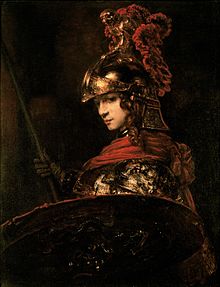
Athena's epithet Pallas – her most renowned one – is derived either from πάλλω, meaning "to brandish [as a weapon]", or, more likely, from παλλακίς and related words, meaning "youth, young woman".[55] On this topic, Walter Burkert says "she is the Pallas of Athens, Pallas Athenaie, just as Hera of Argos is Here Argeie."[6] In later times, after the original meaning of the name had been forgotten, the Greeks invented myths to explain its origins, such as those reported by the Epicurean philosopher Philodemus and the Bibliotheca of Pseudo-Apollodorus, which claim that Pallas was originally a separate entity, whom Athena had slain in combat.[56]
In one version of the myth, Pallas was the daughter of the sea-god Triton,[57] and she and Athena were childhood friends. Zeus one day watched Athena and Pallas have a friendly sparring match. Not wanting his daughter to lose, Zeus flapped his aegis to distract Pallas, whom Athena accidentally impaled.[58] Distraught over what she had done, Athena took the name Pallas for herself as a sign of her grief and tribute to her friend and Zeus gave her the aegis as an apology.[58] In another version of the story, Pallas was a Giant;[59] Athena slew him during the Gigantomachy and flayed off his skin to make her cloak, which she wore as a victory trophy.[59][15][60][61] In an alternative variation of the same myth, Pallas was instead Athena's father,[59][15] who attempted to assault his own daughter,[62] causing Athena to kill him and take his skin as a trophy.[63]
The palladium was a statue of Athena that was said to have stood in her temple on the Trojan Acropolis.[64] Athena was said to have carved the statue herself in the likeness of her dead friend Pallas.[64] The statue had special talisman-like properties[64] and it was thought that, as long as it was in the city, Troy could never fall.[64] When the Greeks captured Troy, Cassandra, the daughter of Priam, clung to the palladium for protection,[64] but Ajax the Lesser violently tore her away from it and dragged her over to the other captives.[64] Athena was infuriated by this violation of her protection.[65] Although Agamemnon attempted to placate her anger with sacrifices, Athena sent a storm at Cape Kaphereos to destroy almost the entire Greek fleet and scatter all of the surviving ships across the Aegean.[66]
Glaukopis

In Homer's epic works, Athena's most common epithet is Glaukopis (γλαυκῶπις), which usually is translated as, "bright-eyed" or "with gleaming eyes".[67] The word is a combination of glaukós (γλαυκός, meaning "gleaming, silvery", and later, "bluish-green" or "gray")[68] and ṓps (ὤψ, "eye, face").[69]
The word glaúx (γλαύξ,[70] "little owl")[71] is from the same root, presumably according to some, because of the bird's own distinctive eyes. Athena was associated with the owl from very early on;[72] in archaic images, she is frequently depicted with an owl perched on her hand.[72] Through its association with Athena, the owl evolved into the national mascot of the Athenians and eventually became a symbol of wisdom.[5]
Tritogeneia
In the Iliad (4.514), the Odyssey (3.378), the Homeric Hymns, and in Hesiod's Theogony, Athena is also given the curious epithet Tritogeneia (Τριτογένεια), whose significance remains unclear.[73] It could mean various things, including "Triton-born", perhaps indicating that the homonymous sea-deity was her parent according to some early myths.[73] One myth relates the foster father relationship of this Triton towards the half-orphan Athena, whom he raised alongside his own daughter Pallas.[57] Kerényi suggests that "Tritogeneia did not mean that she came into the world on any particular river or lake, but that she was born of the water itself; for the name Triton seems to be associated with water generally."[74][75] In Ovid's Metamorphoses, Athena is occasionally referred to as "Tritonia".
Another possible meaning may be "triple-born" or "third-born", which may refer to a triad or to her status as the third daughter of Zeus or the fact she was born from Metis, Zeus, and herself; various legends list her as being the first child after Artemis and Apollo, though other legends identify her as Zeus' first child.[76] Several scholars have suggested a connection to the Rigvedic god Trita,[77] who was sometimes grouped in a body of three mythological poets.[77] Michael Janda has connected the myth of Trita to the scene in the Iliad in which the "three brothers" Zeus, Poseidon, and Hades divide the world between them, receiving the "broad sky", the sea, and the underworld respectively.[78][79] Janda further connects the myth of Athena being born of the head (i. e. the uppermost part) of Zeus, understanding Trito- (which perhaps originally meant "the third") as another word for "the sky".[78] In Janda's analysis of Indo-European mythology, this heavenly sphere is also associated with the mythological body of water surrounding the inhabited world (cfr. Triton's mother, Amphitrite).[78]
Yet another possible meaning is mentioned in Diogenes Laertius' biography of Democritus, that Athena was called "Tritogeneia" because three things, on which all mortal life depends, come from her.[80]
Cult and patronages
Panhellenic and Athenian cult
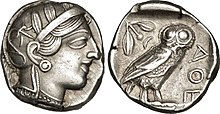
| Part of a series on |
| Ancient Greek religion |
|---|
 |
In her aspect of Athena Polias, Athena was venerated as the goddess of the city and the protectress of the citadel.[15][81][45] In Athens, the Plynteria, or "Feast of the Bath", was observed every year at the end of the month of Thargelion.[82] The festival lasted for five days. During this period, the priestesses of Athena, or plyntrídes, performed a cleansing ritual within the Erechtheion, a sanctuary devoted to Athena and Poseidon.[83] Here Athena's statue was undressed, her clothes washed, and body purified.[83] Athena was worshipped at festivals such as Chalceia as Athena Ergane,[84][45] the patroness of various crafts, especially weaving.[84][45] She was also the patron of metalworkers and was believed to aid in the forging of armor and weapons.[84] During the late fifth century BC, the role of goddess of philosophy became a major aspect of Athena's cult.[85]

As Athena Promachos, she was believed to lead soldiers into battle.[86][43] Athena represented the disciplined, strategic side of war, in contrast to her brother Ares, the patron of violence, bloodlust, and slaughter—"the raw force of war".[87][88] Athena was believed to only support those fighting for a just cause[87] and was thought to view war primarily as a means to resolve conflict.[87] The Greeks regarded Athena with much higher esteem than Ares.[87][88] Athena was especially worshipped in this role during the festivals of the Panathenaea and Pamboeotia,[89] both of which prominently featured displays of athletic and military prowess.[89] As the patroness of heroes and warriors, Athena was believed to favor those who used cunning and intelligence rather than brute strength.[90]

In her aspect as a warrior maiden, Athena was known as Parthenos (Παρθένος "virgin"),[86][92][93] because, like her fellow goddesses Artemis and Hestia, she was believed to remain perpetually a virgin.[94][95][86][93][96] Athena's most famous temple, the Parthenon on the Athenian Acropolis, takes its name from this title.[96] According to Karl Kerényi, a scholar of Greek mythology, the name Parthenos is not merely an observation of Athena's virginity, but also a recognition of her role as enforcer of rules of sexual modesty and ritual mystery.[96] Even beyond recognition, the Athenians allotted the goddess value based on this pureness of virginity, which they upheld as a rudiment of female behavior.[96] Kerényi's study and theory of Athena explains her virginal epithet as a result of her relationship to her father Zeus and a vital, cohesive piece of her character throughout the ages.[96] This role is expressed in several stories about Athena. Marinus of Neapolis reports that when Christians removed the statue of the goddess from the Parthenon, a beautiful woman appeared in a dream to Proclus, a devotee of Athena, and announced that the "Athenian Lady" wished to dwell with him.[97]
Athena was also credited with creating the pebble-based form of divination. Those pebbles were called thriai, which was also the collective name of a group of nymphs with prophetic powers. Her half-brother Apollo however, angered and spiteful at the practitioners of an art rival to his own, complained to their father Zeus about it, with the pretext that many people took to casting pebbles, but few actually were true prophets. Zeus, sympathizing with Apollo's grievances, discredited the pebble divination by rendering the pebbles useless. Apollo's words became the basis of an ancient Greek idiom.[98]
Regional cults

Athena was not only the patron goddess of Athens, but also other cities, including Pergamon,[42] Argos, Sparta, Gortyn, Lindos, and Larisa.[43] The various cults of Athena were all branches of her panhellenic cult[43] and often proctored various initiation rites of Grecian youth, such as the passage into citizenship by young men or the passage of young women into marriage.[43] These cults were portals of a uniform socialization, even beyond mainland Greece.[43] Athena was frequently equated with Aphaea, a local goddess of the island of Aegina, originally from Crete and also associated with Artemis and the nymph Britomartis.[99] In Arcadia, she was assimilated with the ancient goddess Alea and worshiped as Athena Alea.[100] Sanctuaries dedicated to Athena Alea were located in the Laconian towns of Mantineia and Tegea. The temple of Athena Alea in Tegea was an important religious center of ancient Greece.[g] The geographer Pausanias was informed that the temenos had been founded by Aleus.[101]
Athena had a major temple on the Spartan Acropolis,[102][45] where she was venerated as Poliouchos and Khalkíoikos ("of the Brazen House", often latinized as Chalcioecus).[102][45] This epithet may refer to the fact that cult statue held there may have been made of bronze,[102] that the walls of the temple itself may have been made of bronze,[102] or that Athena was the patron of metal-workers.[102] Bells made of terracotta and bronze were used in Sparta as part of Athena's cult.[102] An Ionic-style temple to Athena Polias was built at Priene in the fourth century BC.[103] It was designed by Pytheos of Priene,[104] the same architect who designed the Mausoleum at Halicarnassus.[104] The temple was dedicated by Alexander the Great[105] and an inscription from the temple declaring his dedication is now held in the British Museum.[103]
In Pergamon, Athena was thought to have been a god of the cosmos and the aspects of it that aided Pergamon and its fate.[42]
Mythology
Birth


She was the daughter of Zeus, produced without a mother, and emerged full-grown from his forehead. There was an alternate story that Zeus swallowed Metis, the goddess of counsel, while she was pregnant with Athena and when she was fully grown she emerged from Zeus' forehead. Being the favorite child of Zeus, she had great power.In the classical Olympian pantheon, Athena was regarded as the favorite child of Zeus, born fully armed from his forehead.[106][107][108][h] The story of her birth comes in several versions.[109][110][111] The earliest mention is in Book V of the Iliad, when Ares accuses Zeus of being biased in favor of Athena because "autos egeinao" (literally "you fathered her", but probably intended as "you gave birth to her").[112][113]She was essentially urban and civilized, the antithesis in many respects of Artemis, goddess of the outdoors. Athena was probably a pre-Hellenic goddess and was later taken over by the Greeks.In the version recounted by Hesiod in his Theogony, Zeus married the goddess Metis, who is described as the "wisest among gods and mortal men", and engaged in sexual intercourse with her.[114][115][113][116] After learning that Metis was pregnant, however, he became afraid that the unborn offspring would try to overthrow him, because Gaia and Ouranos had prophesied that Metis would bear children wiser than their father.[114][115][113][116] In order to prevent this, Zeus tricked Metis into letting him swallow her, but it was too late because Metis had already conceived.[114][117][113][116] A later account of the story from the Bibliotheca of Pseudo-Apollodorus, written in the second century AD, makes Metis Zeus's unwilling sexual partner, rather than his wife.[118][119] According to this version of the story, Metis transformed into many different shapes in effort to escape Zeus,[118][119] but Zeus successfully raped her and swallowed her.[118][119]
After swallowing Metis, Zeus took six more wives in succession until he married his seventh and present wife, Hera.[116] Then Zeus experienced an enormous headache.[120][113][116] He was in such pain that he ordered someone (either Prometheus, Hephaestus, Hermes, Ares, or Palaemon, depending on the sources examined) to cleave his head open with the labrys, the double-headed Minoan axe.[59][113][121][119] Athena leaped from Zeus's head, fully grown and armed.[59][113][108][122] The "First Homeric Hymn to Athena" states in lines 9–16 that the gods were awestruck by Athena's appearance[123] and even Helios, the god of the sun, stopped his chariot in the sky.[123] Pindar, in his "Seventh Olympian Ode", states that she "cried aloud with a mighty shout" and that "the Sky and mother Earth shuddered before her."[124][123]
Hesiod states that Hera was so annoyed at Zeus for having given birth to a child on his own that she conceived and bore Hephaestus by herself,[116] but in Imagines 2. 27 (trans. Fairbanks), the third-century AD Greek rhetorician Philostratus the Elder writes that Hera "rejoices" at Athena's birth "as though Athena were her daughter also." The second-century AD Christian apologist Justin Martyr takes issue with those pagans who erect at springs images of Kore, whom he interprets as Athena: "They said that Athena was the daughter of Zeus not from intercourse, but when the god had in mind the making of a world through a word (logos) his first thought was Athena."[125] According to a version of the story in a scholium on the Iliad (found nowhere else), when Zeus swallowed Metis, she was pregnant with Athena by the Cyclops Brontes.[126] The Etymologicum Magnum[127] instead deems Athena the daughter of the Daktyl Itonos.[128] Fragments attributed by the Christian Eusebius of Caesarea to the semi-legendary Phoenician historian Sanchuniathon, which Eusebius thought had been written before the Trojan war, make Athena instead the daughter of Cronus, a king of Byblos who visited "the inhabitable world" and bequeathed Attica to Athena.[129][130]
Lady of Athens
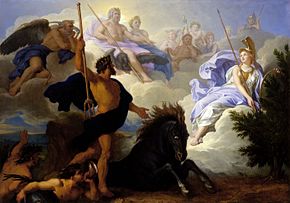
In Homer's Iliad, Athena, as a war goddess, inspired and fought alongside the Greek heroes; her aid was synonymous with military prowess. Also in the Iliad, Zeus, the chief god, specifically assigned the sphere of war to Ares, the god of war, and Athena. Athena's moral and military superiority to Ares derived in part from the fact that she represented the intellectual and civilized side of war and the virtues of justice and skill, whereas Ares represented mere blood lust. Her superiority also derived in part from the vastly greater variety and importance of her functions and the patriotism of Homer's predecessors, Ares being of foreign origin. In the Iliad, Athena was the divine form of the heroic, martial ideal: she personified excellence in close combat, victory, and glory. The qualities that led to victory were found on the aegis, or breastplate, that Athena wore when she went to war: fear, strife, defense, and assault. Athena appears in Homer's Odyssey as the tutelary deity of Odysseus, and myths from later sources portray her similarly as the helper of Perseus and Heracles (Hercules). As the guardian of the welfare of kings, Athena became the goddess of good counsel, prudent restraint and practical insight, and war.In a founding myth reported by Pseudo-Apollodorus,[127] Athena competed with Poseidon for the patronage of Athens.[131] They agreed that each would give the Athenians one gift[131] and that Cecrops, the king of Athens, would determine which gift was better.[131] Poseidon struck the ground with his trident and a salt water spring sprang up;[131] this gave the Athenians access to trade and water.[132] Athens at its height was a significant sea power, defeating the Persian fleet at the Battle of Salamis[132]—but the water was salty and undrinkable.[132] In an alternative version of the myth from Vergil's Georgics,[127] Poseidon instead gave the Athenians the first horse.[131] Athena offered the first domesticated olive tree.[131][93] Cecrops accepted this gift[131] and declared Athena the patron goddess of Athens.[131] The olive tree brought wood, oil, and food,[132] and became a symbol of Athenian economic prosperity.[93][133] Robert Graves was of the opinion that "Poseidon's attempts to take possession of certain cities are political myths",[132] which reflect the conflict between matriarchal and patriarchal religions.[132]

Afterwards, Poseidon was so angry over his defeat that he sent one of his sons, Halirrhothius, to cut down the tree. But as he swung his axe, he missed his aim and it fell in himself, killing him. This was supposedly the origin of calling Athena's sacred olive tree moria, for Halirrhotius's attempt at revenge proved fatal (moros in Greek). Poseidon in fury accused Ares of murder, and the matter was eventually settled on the Areopagus ("hill of Ares") in favour of Ares, which was thereafter named after the event.[135][136]
Pseudo-Apollodorus[127] records an archaic legend, which claims that Hephaestus once attempted to rape Athena, but she pushed him away, causing him to ejaculate on her thigh.[137][91][138] Athena wiped the semen off using a tuft of wool, which she tossed into the dust,[137][91][138] impregnating Gaia and causing her to give birth to Erichthonius.[137][91][138] Athena adopted Erichthonius as her son and raised him.[137][138] The Roman mythographer Hyginus[127] records a similar story in which Hephaestus demanded Zeus to let him marry Athena since he was the one who had smashed open Zeus's skull, allowing Athena to be born.[137] Zeus agreed to this and Hephaestus and Athena were married,[137] but, when Hephaestus was about to consummate the union, Athena vanished from the bridal bed, causing him to ejaculate on the floor, thus impregnating Gaia with Erichthonius.[137]
The geographer Pausanias[127] records that Athena placed the infant Erichthonius into a small chest[139] (cista), which she entrusted to the care of the three daughters of Cecrops: Herse, Pandrosos, and Aglauros of Athens.[139] She warned the three sisters not to open the chest,[139] but did not explain to them why or what was in it.[139] Aglauros, and possibly one of the other sisters,[139] opened the chest.[139] Differing reports say that they either found that the child itself was a serpent, that it was guarded by a serpent, that it was guarded by two serpents, or that it had the legs of a serpent.[140] In Pausanias's story, the two sisters were driven mad by the sight of the chest's contents and hurled themselves off the Acropolis, dying instantly,[141] but an Attic vase painting shows them being chased by the serpent off the edge of the cliff instead.[141]
Erichthonius was one of the most important founding heroes of Athens[91] and the legend of the daughters of Cecrops was a cult myth linked to the rituals of the Arrhephoria festival.[91][142] Pausanias records that, during the Arrhephoria, two young girls known as the Arrhephoroi, who lived near the temple of Athena Polias, would be given hidden objects by the priestess of Athena,[143] which they would carry on their heads down a natural underground passage.[143] They would leave the objects they had been given at the bottom of the passage and take another set of hidden objects,[143] which they would carry on their heads back up to the temple.[143] The ritual was performed in the dead of night[143] and no one, not even the priestess, knew what the objects were.[143] The serpent in the story may be the same one depicted coiled at Athena's feet in Pheidias's famous statue of the Athena Parthenos in the Parthenon.[134] Many of the surviving sculptures of Athena show this serpent.[134]
Herodotus records that a serpent lived in a crevice on the north side of the summit of the Athenian Acropolis[134] and that the Athenians left a honey cake for it each month as an offering.[134] On the eve of the Second Persian invasion of Greece in 480 BC, the serpent did not eat the honey cake[134] and the Athenians interpreted it as a sign that Athena herself had abandoned them.[134] Another version of the myth of the Athenian maidens is told in Metamorphoses by the Roman poet Ovid (43 BC – 17 AD); in this late variant Hermes falls in love with Herse. Herse, Aglaulus, and Pandrosus go to the temple to offer sacrifices to Athena. Hermes demands help from Aglaulus to seduce Herse. Aglaulus demands money in exchange. Hermes gives her the money the sisters have already offered to Athena. As punishment for Aglaulus's greed, Athena asks the goddess Envy to make Aglaulus jealous of Herse. When Hermes arrives to seduce Herse, Aglaulus stands in his way instead of helping him as she had agreed. He turns her to stone.[144]
Athena gave her favour to an Attic girl named Myrsine, a chaste girl who outdid all her fellow athletes in both the palaestra and the race. Out of envy, the other athletes murdered her, but Athena took pity in her and transformed her dead body into a myrtle, a plant thereafter as favoured by her as the olive was.[145] An almost exact story was said about another girl, Elaea, who transformed into an olive, Athena's sacred tree.[146]
Patron of heroes

According to Pseudo-Apollodorus's Bibliotheca, Athena advised Argos, the builder of the Argo, the ship on which the hero Jason and his band of Argonauts sailed, and aided in the ship's construction.[148][149] Pseudo-Apollodorus also records that Athena guided the hero Perseus in his quest to behead Medusa.[150][151][152] She and Hermes, the god of travelers, appeared to Perseus after he set off on his quest and gifted him with tools he would need to kill the Gorgon.[152][153] Athena lent Perseus her polished bronze shield to view Medusa's reflection without becoming petrified himself.[152][154] Hermes lent Perseus his harpe to behead Medusa with.[152][155] When Perseus swung the blade to behead Medusa, Athena guided it, allowing the blade to cut the Gorgon's head clean off.[152][154] According to Pindar's Thirteenth Olympian Ode, Athena helped the hero Bellerophon tame the winged horse Pegasus by giving him a bit.[156][157]
In ancient Greek art, Athena is frequently shown aiding the hero Heracles.[158] She appears in four of the twelve metopes on the Temple of Zeus at Olympia depicting Heracles's Twelve Labors,[159][158] including the first, in which she passively watches him slay the Nemean lion,[158] and the tenth, in which she is shown actively helping him hold up the sky.[160] She is presented as his "stern ally",[161] but also the "gentle... acknowledger of his achievements."[161] Artistic depictions of Heracles's apotheosis show Athena driving him to Mount Olympus in her chariot and presenting him to Zeus for his deification.[160] In Aeschylus's tragedy Orestes, Athena intervenes to save Orestes from the wrath of the Erinyes and presides over his trial for the murder of his mother Clytemnestra.[162] When half the jury votes to acquit and the other half votes to convict, Athena casts the deciding vote to acquit Orestes[162] and declares that, from then on, whenever a jury is tied, the defendant shall always be acquitted.[163]
In The Odyssey, Odysseus' cunning and shrewd nature quickly wins Athena's favour.[164][149] For the first part of the poem, however, she largely is confined to aiding him only from afar, mainly by implanting thoughts in his head during his journey home from Troy. Her guiding actions reinforce her role as the "protectress of heroes," or, as mythologian Walter Friedrich Otto dubbed her, the "goddess of nearness", due to her mentoring and motherly probing.[165][150][166] It is not until he washes up on the shore of the island of the Phaeacians, where Nausicaa is washing her clothes that Athena arrives personally to provide more tangible assistance.[167] She appears in Nausicaa's dreams to ensure that the princess rescues Odysseus and plays a role in his eventual escort to Ithaca.[168] Athena appears to Odysseus upon his arrival, disguised as a herdsman;[169][170][164] she initially lies and tells him that Penelope, his wife, has remarried and that he is believed to be dead,[169] but Odysseus lies back to her, employing skillful prevarications to protect himself.[171][170] Impressed by his resolve and shrewdness, she reveals herself and tells him what he needs to know to win back his kingdom.[172][170][164] She disguises him as an elderly beggar so that he will not be recognized by the suitors or Penelope,[173][170] and helps him to defeat the suitors.[173][174][170] Athena also appears to Odysseus's son Telemachus.[175] Her actions lead him to travel around to Odysseus's comrades and ask about his father.[176] He hears stories about some of Odysseus's journey.[176] Athena's push for Telemachus's journey helps him grow into the man role, that his father once held.[177] She also plays a role in ending the resultant feud against the suitors' relatives. She instructs Laertes to throw his spear and to kill Eupeithes, the father of Antinous.
- Athena, detail from a silver kantharos with Theseus in Crete (c. 440-435 BC), part of the Vassil Bojkov collection, Sofia, Bulgaria
- Silver coin showing Athena with Scylla decorated helmet and Heracles fighting the Nemean lion (Heraclea Lucania, 390-340 BC)
Punishment myths

The Gorgoneion appears to have originated as an apotropaic symbol intended to ward off evil.[178] In a late myth invented to explain the origins of the Gorgon,[179] Medusa is described as having been a young priestess who served in the temple of Athena in Athens.[180] Poseidon lusted after Medusa, and raped her in the temple of Athena,[180] refusing to allow her vow of chastity to stand in his way.[180] Upon discovering the desecration of her temple, Athena transformed Medusa into a hideous monster with serpents for hair whose gaze would turn any mortal to stone.[181]
In his Twelfth Pythian Ode, Pindar recounts the story of how Athena invented the aulos, a kind of flute, in imitation of the lamentations of Medusa's sisters, the Gorgons, after she was beheaded by the hero Perseus.[182] According to Pindar, Athena gave the aulos to mortals as a gift.[182] Later, the comic playwright Melanippides of Melos (c. 480–430 BC) embellished the story in his comedy Marsyas,[182] claiming that Athena looked in the mirror while she was playing the aulos and saw how blowing into it puffed up her cheeks and made her look silly, so she threw the aulos away and cursed it so that whoever picked it up would meet an awful death.[182] The aulos was picked up by the satyr Marsyas, who was later killed by Apollo for his hubris.[182] Later, this version of the story became accepted as canonical[182] and the Athenian sculptor Myron created a group of bronze sculptures based on it, which was installed before the western front of the Parthenon in around 440 BC.[182]
A myth told by the early third-century BC Hellenistic poet Callimachus in his Hymn 5 begins with Athena bathing in a spring on Mount Helicon at midday with one of her favorite companions, the nymph Chariclo.[138][183] Chariclo's son Tiresias happened to be hunting on the same mountain and came to the spring searching for water.[138][183] He inadvertently saw Athena naked, so she struck him blind to ensure he would never again see what man was not intended to see.[138][184][185] Chariclo intervened on her son's behalf and begged Athena to have mercy.[138][185][186] Athena replied that she could not restore Tiresias's eyesight,[138][185][186] so, instead, she gave him the ability to understand the language of the birds and thus foretell the future.[187][186][138]
Myrmex was a clever and chaste Attic girl who became quickly a favourite of Athena. However, when Athena invented the plough, Myrmex went to the Atticans and told them that it was in fact her own invention. Hurt by the girl's betrayal, Athena transformed her into the small insect bearing her name, the ant.[188]
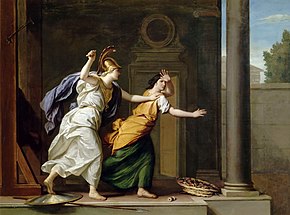
The fable of Arachne appears in Ovid's Metamorphoses (8 AD) (vi.5–54 and 129–145),[189][190][191] which is nearly the only extant source for the legend.[190][191] The story does not appear to have been well known prior to Ovid's rendition of it[190] and the only earlier reference to it is a brief allusion in Virgil's Georgics, (29 BC) (iv, 246) that does not mention Arachne by name.[191] According to Ovid, Arachne (whose name means spider in ancient Greek[192]) was the daughter of a famous dyer in Tyrian purple in Hypaipa of Lydia, and a weaving student of Athena.[193] She became so conceited of her skill as a weaver that she began claiming that her skill was greater than that of Athena herself.[193][194] Athena gave Arachne a chance to redeem herself by assuming the form of an old woman and warning Arachne not to offend the deities.[189][194] Arachne scoffed and wished for a weaving contest, so she could prove her skill.[195][194]
Athena wove the scene of her victory over Poseidon in the contest for the patronage of Athens.[195][196][194] Athena's tapestry also depicted the 12 Olympian gods and defeat of mythological figures who challenged their authority.[197] Arachne's tapestry featured twenty-one episodes of the deities' infidelity,[195][196][194] including Zeus being unfaithful with Leda, with Europa, and with Danaë.[196] It represented the unjust and discrediting behavior of the gods towards mortals.[197] Athena admitted that Arachne's work was flawless,[195][194][196] but was outraged at Arachne's offensive choice of subject, which displayed the failings and transgressions of the deities.[195][194][196] Finally, losing her temper, Athena destroyed Arachne's tapestry and loom, striking it with her shuttle.[195][194][196] Athena then struck Arachne across the face with her staff four times.[195][194][196] Arachne hanged herself in despair,[195][194][196] but Athena took pity on her and brought her back from the dead in the form of a spider.[195][194][196]
In a rarer version, surviving in the scholia of an unnamed scholiast on Nicander, whose works heavily influenced Ovid, Arachne is placed in Attica instead and has a brother named Phalanx. Athena taught Arachne the art of weaving and Phalanx the art of war, but when brother and sister laid together in bed, Athena was so disgusted with them that she turned them both into spiders, animals forever doomed to be eaten by their own young.[198]
Trojan War

The myth of the Judgement of Paris is mentioned briefly in the Iliad,[199] but is described in depth in an epitome of the Cypria, a lost poem of the Epic Cycle,[200] which records that all the gods and goddesses as well as various mortals were invited to the marriage of Peleus and Thetis (the eventual parents of Achilles).[199] Only Eris, goddess of discord, was not invited.[200] She was annoyed at this, so she arrived with a golden apple inscribed with the word καλλίστῃ (kallistēi, "for the fairest"), which she threw among the goddesses.[201] Aphrodite, Hera, and Athena all claimed to be the fairest, and thus the rightful owner of the apple.[201][138]
Богини решили передать дело Зевсу, который, не желая отдавать предпочтение одной из богинь, передал выбор в руки Париса, троянского принца. [201] [138] После омовения в источнике на горе Ида , где находилась Троя, богини предстали перед Парисом для его решения. [201] На дошедших до нас античных изображениях Суда Париса Афродита лишь изредка изображается обнаженной, а Афина и Гера всегда полностью одетыми. [202] Однако со времен Возрождения западные картины обычно изображали всех трех богинь совершенно обнаженными. [202]
Все три богини были идеально красивы, и Парис не мог сделать выбор между ними, поэтому прибегнул к взяткам. [201] Гера пыталась подкупить Париса властью над всей Азией и Европой, [201] [138] и Афина предложила славу и славу в битве, [201] [138] но Афродита пообещала Парису, что, если он выберет ее как прекраснейшую, она позволит ему жениться на самой красивой женщине на земле. [203] [138] Этой женщиной была Елена уже была замужем за царем Менелаем Спарты , которая . [203] Парис выбрал Афродиту и вручил ей яблоко. [203] [138] Две другие богини были в ярости и, как следствие, встали на сторону греков в Троянской войне . [203] [138]

В V–VI книгах «Илиады » Афина помогает герою Диомеду , который в отсутствие Ахилла показывает себя самым эффективным греческим воином. [204] [149] На нескольких художественных изображениях начала шестого века до нашей эры могут быть изображены Афина и Диомед. [204] в том числе полоса на щите начала шестого века до нашей эры, изображающая Афину и неопознанного воина, едущих на колеснице, вазу с изображением воина с его возничим, обращенным к Афине, и глиняную доску с надписью, изображающую Диомеда и Афину, едущих в колеснице. [204] В многочисленных отрывках «Илиады» также упоминается Афина, ранее служившая покровительницей отца Диомеда Тидея . [205] [206] Когда троянки приходят в храм Афины на Акрополе, чтобы просить ее о защите от Диомеда, Афина их игнорирует. [65]
В XXII книге «Илиады » , пока Ахиллес преследует Гектора вокруг стен Трои, Афина появляется перед Гектором, замаскированная под его брата Деифоба. [207] и убеждает его держаться на своем, чтобы они могли вместе сразиться с Ахиллом. [207] Затем Гектор бросает копье в Ахилла и промахивается, ожидая, что Деифоб передаст ему другое. [208] но вместо этого Афина исчезает, оставляя Гектора один на один с Ахиллом без копья. [208] В Софокла трагедии «Аякс » она наказывает соперника Одиссея Аякса Великого , сводя его с ума и заставляя убивать скот ахейцев, думая, что он убивает самих ахейцев. [209] Даже после того, как сам Одиссей выразил жалость к Аяксу, [210] Афина заявляет: «Смеяться над своими врагами – что может быть слаще смеха, чем этот?» (строки 78–9). [210] Позже Аякс покончил жизнь самоубийством из-за своего унижения. [210]
Классическое искусство
Афина часто появляется в классическом греческом искусстве, в том числе на монетах и росписях на керамике. [211] [212] Она особенно заметна в произведениях, созданных в Афинах. [211] В классических изображениях Афина обычно изображается стоящей, одетой в хитон во всю длину . [213] Чаще всего ее изображают одетой в доспехи, как мужчина-солдат. [212] [213] [10] и носила коринфский шлем, высоко поднятый на лбу. [214] [10] [212] В центре ее щита изображена эгида с головой горгоны ( горгонейон ) в центре и змеей по краям. [179] Иногда ее изображают носящей эгиду вместо плаща. [212] В образе Афины Промахос она изображена размахивающей копьем. [211] [10] [212] Сцены, в которых была изображена Афина, включают ее рождение из головы Зевса, ее битву с гигантами , рождение Эрихтония и Суд Париса. [211]
Скорбящая Афина или Медитирующая Афина — знаменитая рельефная скульптура, датируемая примерно 470–460 гг. до н.э. [214] [211] это было интерпретировано как изображение Афины Полиас. [214] Самым известным классическим изображением Афины была Афина Парфенос , ныне утраченная статуя высотой 11,5 м (38 футов). [215] золота и слоновой кости Ее статуя из в Парфеноне создана афинским скульптором Фидием . [213] [211] Копии показывают, что эта статуя изображала Афину, держащую свой щит в левой руке, а Нику , крылатую богиню победы, стоящую в правой. [211] Афина Полиас также представлена на неоаттическом рельефе, который сейчас хранится в Музее изящных искусств Вирджинии . [214] на котором она изображена держащей в руке сову [я] и носила свой характерный коринфский шлем, прислоняя щит к ближайшей герме . [214] Римская богиня Минерва переняла большинство греческих иконографических ассоциаций Афины. [216] но также был интегрирован в Капитолийскую триаду . [216]
- Аттический чернофигурный эксалептрон рождения Афины из головы Зевса ( ок. 570–560 до н.э.) работы художника С. [211]
- Аттический краснофигурный киликс Афины Промахос, держащей копье и стоящей рядом с дорической колонной ( ок. 500–490 до н. э.)
- Реставрация полихромного декора статуи Афины из храма Афеи на Эгине , ок. 490 г. до н. э. (из экспозиции «Бунте Гёттер» Мюнхенской глиптотеки )
- Аттический краснофигурный киликс, изображающий Афину, убивающую гигантского Энцелада ( ок. 550–500 до н.э.)
- Рельеф с изображением Афины и Ники, убивающих великана Алкионея (?) с фриза гигантомахии на Пергамском алтаре (начало II века до н. э.)
- Классическая мозаика с виллы в Тускулуме , III век нашей эры, сейчас находится в Музее Пио-Клементино , Ватикан.
- Портрет Афины работы Евклида на тетрадрахме из Сиракуз, Сицилия ок. 400 г. до н.э.
- Мифологическая сцена с Афиной (слева) и Гераклом (справа) на каменной палитре греко -буддийского искусства Гандхары , Индия.
- Атена Фарнезе , римская копия греческого оригинала из круга Фидия, ок. 430 г. н. э., Археологический музей, Неаполь.
- Афина (2 век до н. э.) в искусстве Гандхары , выставлена в Лахорском музее , Пакистан.
Постклассическая культура
Искусство и символика

Ранние христианские писатели, такие как Климент Александрийский и Фирмик , очерняли Афину как олицетворение всего того, что было отвратительно в язычестве; [218] они осудили ее как «нескромную и аморальную». [219] Однако в средние века многие атрибуты Афины были переданы Деве Марии . [219] который на изображениях четвертого века часто изображался носящим Горгонейон . [219] Некоторые даже считали Деву Марию девушкой-воином, очень похожей на Афину Парфенос; [219] Один анекдот рассказывает, что однажды Дева Мария появилась на стенах Константинополя , когда он был осаждён аварами, сжимая копье и призывая народ к битве. [220] В средние века Афина стала широко использоваться как христианский символ и аллегория, и она появлялась на семейных гербах некоторых знатных домов. [221]
В эпоху Возрождения Афина носила мантию покровительницы искусств и человеческой деятельности; [222] аллегорические картины с участием Афины были фаворитами итальянских художников эпохи Возрождения. [222] На Сандро Боттичелли картине «Паллада и Кентавр» , написанной, вероятно, где-то в 1480-х годах, Афина является олицетворением целомудрия, она изображена сжимающей чуб кентавра, олицетворяющего похоть. [223] [224] В картине Андреа Мантенья 1502 года «Минерва, изгоняющая пороки из сада добродетели» Афина используется как олицетворение греко-римской учености, преследующей пороки средневековья из сада современной науки. [225] [224] [226] Афина также используется как олицетворение мудрости в картине Бартоломеуса Спрангера 1591 года «Триумф мудрости или Минерва, победившая невежество» . [216]
В шестнадцатом и семнадцатом веках Афина использовалась как символ женщин-правительниц. [227] В своей книге «Откровение истинной Минервы» (1582 г.) Томас Бленнерхассет изображает королеву Англии Елизавету I как «новую Минерву» и «величайшую богиню ныне на земле». [228] В серии картин Питера Пауля Рубенса Афина изображена как Марии Медичи ; покровительница и наставница [229] последняя картина серии идет еще дальше и изображает Марию Медичи с иконографией Афины как смертное воплощение самой богини. [229] Фламандский скульптор Жан-Пьер-Антуан Тассер (Ян Петер Антон Тассер) позже изобразил Екатерину II в образе Афины в мраморном бюсте в 1774 году. [216] Во время Французской революции статуи языческих богов сносили по всей Франции, а статуи Афины — нет. [229] Вместо этого Афина превратилась в олицетворение свободы и республики. [229] а статуя богини стояла в центре площади Революции в Париже. [229] В годы после революции художественные изображения Афины получили широкое распространение. [230]
Статуя Афины стоит прямо перед зданием австрийского парламента в Вене. [231] и изображения Афины повлияли на другие символы западной свободы, включая Статую Свободы и Британию . [231] уже более века Полномасштабная копия Парфенона стоит в Нэшвилле, штат Теннесси . [232] В 1990 году кураторы добавили позолоченную работы Фидия копию Афины Парфенос высотой сорок два фута (12,5 м) , построенную из бетона и стекловолокна. [232] На Большой печати Калифорнии изображена Афина, стоящая на коленях рядом с бурым медведем гризли. [233] Афина время от времени появлялась на современных монетах, как, например, на древней афинской драхме . Ее голова изображена на памятной панамско-тихоокеанской монете номиналом 50 долларов 1915-S . [234]
- Паллада и Кентавр ( ок. 1482) автора Сандро Боттичелли
- Афина, презирающая успехи Гефеста ( ок. 1555–1560), автор Пэрис Бордоне.
- Минерва, победившая невежество ( ок. 1591), автор Бартоломеус Шпрангер.
- Мария Медичи (1622 г.) работы Питера Пауля Рубенса , изображающая ее как воплощение Афины. [229]
- Минерва, защищающая мир от Марса (1629) Питера Пауля Рубенса
- Минерва открывает Итаку Улиссу (пятнадцатый век) автора Джузеппе Боттани
- Бой Марса и Минервы (1771) Жозефа-Бенуа Суве
- Мозаика Минервы Мира в Библиотеке Конгресса
- Афина на Большой печати Калифорнии
- Помпеях Римская фреска в изображает Аякса, утаскивающего Кассандру из Палладия во время падения Трои , события, которое вызвало гнев Афины на греческие армии. [235]
Современные интерпретации

Одним из самых ценных вещей Зигмунда Фрейда была небольшая бронзовая скульптура Афины, стоявшая на его столе. [236] Фрейд однажды описал Афину как «женщину, которая неприступна и отталкивает все сексуальные желания, поскольку она демонстрирует ужасающие гениталии Матери». [237] Взгляды феминисток на Афину резко разделились; [237] некоторые феминистки считают ее символом расширения прав и возможностей женщин, [237] в то время как другие считают ее «абсолютной патриархальной предательницей... которая использует свои силы для продвижения и продвижения мужчин, а не представителей своего пола». [237] В современной Викке Афина почитается как аспект Богини . [238] и некоторые виккане верят, что она может даровать «Дар Совы» («способность ясно писать и общаться») своим прихожанам. [238] Благодаря своему статусу одной из двенадцати олимпийцев, Афина является главным божеством в эллинизме . [239] неоязыческая религия , которая стремится подлинно возродить и воссоздать религию Древней Греции в современном мире. [240]
Афина является естественным покровителем университетов: в колледже Брин-Мор в Пенсильвании в Большом зале находится статуя Афины (точная копия оригинальной бронзовой статуи из библиотеки искусств и археологии). [241] Традиционно во время экзамена студенты оставляют подношения богине с запиской с просьбой об удаче. [241] или покаяться в случайном нарушении любой из многочисленных других традиций колледжа. [241] Афина Паллада — богиня-покровительница международного социального братства Фи Дельта Тета . [242] Ее сова также является символом братства. [242]
Генеалогия
| Генеалогическое древо Афины |
|---|
См. также
- Атенеум (значения)
- Амбулия — спартанский эпитет, используемый для Афины, Зевса , Кастора и Поллукса.
Примечания
- ↑ В других традициях отец Афины иногда упоминается как Зевс, Паллада , Бронтес или Итон .
- ^ / ə ˈ θ iː n ə / ; Аттический греческий : Αθινᾶ , Афина , или Αθηναία , Афинайя ; Эпический : Αθηναιη , Афинайя ; Дорический язык : Атана , Афана
- ^ / ə ˈ θ iː n iː / ; Ионический : Ἀθήνη , Афина.
- ^ / ˈ p æ l ə s / ; Паллас Паллас
- ^ «Граждане имеют божество для своей основательницы; на египетском языке ее называют Нейт, и они утверждают, что это та же самая, которую эллины называют Афиной; они большие любители афинян и говорят, что они в некотором роде связанных с ними». ( Тимей 21д.)
- ^ Эсхил , Эвменид , т. 292 ф. См. предание, что она была дочерью Нила: см., е. г. Климент Александрийский Протр. 2.28.2; Цицерон, De Natura Deorum 3.59.
- ^ «Это святилище с давних времен пользовалось уважением всех пелопоннесцев и обеспечивало особую безопасность его просителям» (Павсаний, Описание Греции iii.5.6)
- ↑ Знаменитая характеристика Джейн Эллен Харрисон этого мифологического элемента как «отчаянного теологического средства, призванного избавить земную Кору от ее матриархальных условий» (Харрисон 1922:302) никогда не была ни опровергнута, ни подтверждена.
- ^ Роль совы как символа мудрости берет свое начало в связи с Афиной.
- ^ Согласно Гомеру , Илиада 1.570–579 , 14.338 , Одиссея 8.312 , Гефест, очевидно, был сыном Геры и Зевса, см. Ганц, с. 74.
- ^ Согласно Гесиоду , Теогония 927–929 , Гефест был произведен одной Герой, без отца, см. Ганц, с. 74.
- ^ Согласно Гесиоду , Теогония 183–200 , Афродита родилась из отрубленных гениталий Урана, см. Ганц, стр. 99–100.
- ^ Согласно Гомеру , Афродита была дочерью Зевса ( Илиада 3.374 , 20.105 ; Одиссея 8.308 , 320 ) и Дионы ( Илиада 5.370–71 ), см. Ганц, стр. 99–100.
Ссылки
- ^ Кереньи 1951 , стр. 121–122.
- ^ Л. Дэй 1999 , с. 39 .
- ^ Кэмпс, Г. (1 января 1989 г.). «Афина» . Берберская энциклопедия (на французском языке) (7): 1011–1013. дои : 10.4000/энциклопедиябербере.1211 . ISSN 1015-7344 .
- ^ Литературная энциклопедия Мерриам-Вебстера . Мерриам-Вебстер. 1995. с. 81 . ISBN 9780877790426 .
- ^ Перейти обратно: а б Диси и Виллинг 2001 .
- ^ Перейти обратно: а б с д и ж г час Буркерт 1985 , с. 139.
- ^ «Геродот, «История», книга 4, глава 180» . www.perseus.tufts.edu . Проверено 26 июля 2024 г.
Они празднуют ежегодный праздник Афины, где их девушки разделяются на две группы и сражаются друг с другом камнями и палками, таким образом (по их словам) чтят, как и их предки, ту местную богиню, которую мы называем Афиной». , говорят, что она была дочерью Посейдона и Тритонского озера!
- ^ «Пиндар, олимпиец, 7 олимпийцев для Диагора Родосского. Боксерский поединок 464 г. до н. э.» www.perseus.tufts.edu . Проверено 26 июля 2024 г.
когда, благодаря искусству Гефеста с бронзовым топором, Афина спрыгнула с макушки своего отца и громко закричала могучим криком.
- ^ Перейти обратно: а б с д и ж Рак и Стейплс 1994 , с. 24.
- ^ Перейти обратно: а б с д и Пауэлл 2012 , с. 230.
- ^ Бикс 2009 , с. 29.
- ^ Йоренс 1981 , стр. 438–452.
- ^ Перейти обратно: а б с д Хурвит 1999 , с. 14.
- ^ Перейти обратно: а б Нильссон 1967 , стр. 347, 433.
- ^ Перейти обратно: а б с д и ж Буркерт 1985 , с. 140.
- ^ Пухвель 1987 , с. 133.
- ^ Кинсли 1989 , стр. 141–142.
- ^ Перейти обратно: а б с Вентрис и Чедвик 1973 , с. 126
- ^ Чедвик 1976 , стр. 88–89.
- ^ Палайма 2004 , с. 444.
- ^ Буркерт 1985 , с. 44.
- ^ Надпись КО За 1, строка 1.
- ^ Перейти обратно: а б с Бест 1989 , с. 30.
- ^ Милонас 1966 , с. 159.
- ^ Hurwit 1999 , стр. 13–14.
- ^ Фурурмарк 1978 , с. 672.
- ^ Перейти обратно: а б Нильссон 1950 , стр. 496.
- ^ Харрисон 1922:306. Сфр. там же. , с. 307, рис. 84: "Деталь чашки из коллекции Фаина" . Архивировано из оригинала 5 ноября 2004 года . Проверено 6 мая 2007 г. .
- ^ Волькштейн и Крамер 1983 , стр. 92, 193.
- ^ Пухвель 1987 , стр. 133–134.
- ^ Мэллори и Адамс 2006 , с. 433.
- ^ Перейти обратно: а б Пенгласер 1994 , с. 235.
- ^ Диси 2008 , стр. 20–21, 41.
- ^ Пенгласер 1994 , стр. 233–325.
- ^ См. также Геродот, Истории 2: 170–175.
- ^ Бернал 1987 , стр. 21, 51 и далее.
- ^ Фрице 2009 , стр. 221–229.
- ^ Berlinerblau 1999 , с. 93 и след.
- ^ Фрице 2009 , стр. 221–255.
- ^ Джасанофф и Нуссбаум 1996 , с. 194.
- ^ Фрице 2009 , стр. 250–255.
- ^ Перейти обратно: а б с д Янсон, Хорст Вольдемар ; Янсон, Энтони Ф. (2004). Туборг, Сара; Мур, Джулия; Оппенгеймер, Маргарет; Кастро, Анита (ред.). История искусства: западная традиция . Том. 1 (пересмотренное 6-е изд.). Река Аппер-Сэддл, Нью-Джерси: Pearson Education . стр. 111, 160. ISBN. 0-13-182622-0 .
- ^ Перейти обратно: а б с д и ж г час Шмитт 2000 , стр. 1059–1073.
- ^ Гомеровские гимны . Перевод Кэшфорда, Жюля. Лондон: Книги Пингвина. 2003. ISBN 0-14-043782-7 . OCLC 59339816 .
- ^ Перейти обратно: а б с д и ж г Хурвит 1999 , с. 15.
- ^ Перейти обратно: а б с Хаббард 1986 , с. 28.
- ^ Белл 1993 , с. 13.
- ^ Павсаний , т.е. 5. § 3; 41. § 6.
- ^ Джон Цецес , Ликофру , LC .
- ^ Шаус и Венн 2007 , с. 30.
- ^ «Павсаний, Описание Греции, 2.34.8» . Архивировано из оригинала 29 июня 2021 года . Проверено 20 февраля 2021 г.
- ^ «Павсаний, Описание Греции, 2.34.9» . Архивировано из оригинала 24 июня 2021 года . Проверено 20 февраля 2021 г.
- ^ «Житие Перикла 13,8» . Плутарх, Параллельные жизни . uchicago.edu. 1916.
«Параллельные жизни» Плутарха опубликованы в томе. III издания классической библиотеки Леба, 1916 г.
- ^ Лесли А. Бомонт (2013). Детство в древних Афинах: иконография и социальная история . Рутледж. п. 69. ИСБН 978-0415248747 .
- ^ Чантрен, св; New Pauly утверждает, что этимология просто неизвестна.
- ^ Новый Поли Святого Палласа
- ^ Перейти обратно: а б Грейвс 1960 , стр. 50–55.
- ^ Перейти обратно: а б Грейвс 1960 , с. 50.
- ^ Перейти обратно: а б с д и Кереньи 1951 , с. 120.
- ^ Диси 2008 , с. 51.
- ^ Пауэлл 2012 , с. 231.
- ^ Кереньи 1951 , с. 120-121.
- ^ Кереньи 1951 , с. 121.
- ^ Перейти обратно: а б с д и ж Диси 2008 , с. 68.
- ^ Перейти обратно: а б Диси, 2008 , стр. 68–69.
- ^ Диси 2008 , с. 71.
- ^ γλαυκῶπις у Лидделла и Скотта .
- ^ γλαυκός у Лидделла и Скотта .
- ^ ὤψ у Лидделла и Скотта .
- ^ Томпсон, Д'Арси Вентворт (1895). Словарь греческих птиц . Оксфорд, Кларендон Пресс. п. 45.
- ^ γλαύξ у Лидделла и Скотта .
- ^ Перейти обратно: а б Нильссон 1950 , стр. 491–496.
- ^ Перейти обратно: а б Грейвс 1960 , с. 55.
- ^ Кереньи 1951 , с. 128.
- ^ Третичный период в Лидделле и Скотте .
- ^ Гесиод, Теогония II, 886–900.
- ^ Перейти обратно: а б Янда 2005 , с. 289-298.
- ^ Перейти обратно: а б с Янда 2005 , с. 293.
- ^ Гомер, Илиада XV, 187–195.
- ^ «Диоген Лаэртский, Жизнеописания выдающихся философов, КНИГА IX, Глава 7. ДЕМОКРИТ (? 460-357 до н.э.)» .
- ^ Херрингтон 1955 , стр. 11–15.
- ^ Саймон 1983 , с. 46.
- ^ Перейти обратно: а б Саймон 1983 , стр. 46–49.
- ^ Перейти обратно: а б с Херрингтон 1955 , стр. 1–11.
- ^ Буркерт 1985 , стр. 305–337.
- ^ Перейти обратно: а б с Херрингтон 1955 , стр. 11–14.
- ^ Перейти обратно: а б с д Дармон 1992 , стр. 114–115.
- ^ Перейти обратно: а б Хансен 2004 , стр. 123–124.
- ^ Перейти обратно: а б Робертсон 1992 , стр. 90–109.
- ^ Хурвит 1999 , с. 18.
- ^ Перейти обратно: а б с д и ж Буркерт 1985 , с. 143.
- ^ Голдхилл 1986 , с. 121.
- ^ Перейти обратно: а б с д Гарланд 2008 , с. 217.
- ^ Хансен 2004 , стр. 123.
- ^ Голдхилл 1986 , с. 31.
- ^ Перейти обратно: а б с д и Кереньи 1952 .
- ^ «Марин Самарийский, Жизнь Прокла, или О счастье» . tertullian.org . 1925. стр. 15–55.
Перевод Кеннета С. Гатри (пункт:30)
- ^ Аполлодор Афинский 2016 , с. 224 .
- ^ Пилафидис-Уильямс 1998 .
- ^ Йост 1996 , стр. 134–135.
- ^ Павсаний, Описание Греции viii.4.8.
- ^ Перейти обратно: а б с д и ж Диси 2008 , с. 127.
- ^ Перейти обратно: а б Берн 2004 , с. 10.
- ^ Перейти обратно: а б Берн 2004 , с. 11.
- ^ Burn 2004 , стр. 10–11.
- ^ Кереньи 1951 , стр. 118–120.
- ^ Диси 2008 , стр. 17–32.
- ^ Перейти обратно: а б Пенгласер 1994 , стр. 230–231.
- ^ Кереньи 1951 , стр. 118–122.
- ^ Диси 2008 , стр. 17–19.
- ^ Хансен 2004 , стр. 121–123.
- ↑ Илиада, книга V, строка 880.
- ^ Перейти обратно: а б с д и ж г Диси 2008 , с. 18.
- ^ Перейти обратно: а б с Гесиод, Теогония 885–900. Архивировано 24 февраля 2021 года в Wayback Machine , 929e-929t. Архивировано 28 октября 2021 года в Wayback Machine.
- ^ Перейти обратно: а б Кереньи 1951 , стр. 118–119.
- ^ Перейти обратно: а б с д и ж Хансен 2004 , стр. 121–122.
- ^ Кереньи 1951 , с. 119.
- ^ Перейти обратно: а б с Псевдо-Аполлодор, Библиотека 1.3.6. Архивировано 24 февраля 2021 года в Wayback Machine.
- ^ Перейти обратно: а б с д Хансен 2004 , стр. 122–123.
- ^ Кереньи 1951 , стр. 119–120.
- ^ Пенгласер 1994 , с. 231.
- ^ Хансен 2004 , стр. 122–124.
- ^ Перейти обратно: а б с Пенгласер 1994 , с. 233.
- ^ Пиндар , « Ода седьмому олимпийскому чемпиону. Архивировано 25 февраля 2021 года в Wayback Machine », строки 37–38.
- ^ Джастин, Апология 64.5, цитируется в книге Роберта МакКуина Гранта, «Боги и единый Бог» , том. 1:155, который отмечает, что именно Порфирий «сходным образом отождествляет Афину с «предусмотрительностью» » .
- ^ Ганц, с. 51; Ясумура, с. 89. Архивировано 27 декабря 2022 года в Wayback Machine ; схолия bT к Илиаде 8.39.
- ^ Перейти обратно: а б с д и ж Кереньи 1951 , с. 281.
- ^ Кереньи 1951 , с. 122.
- ^ Ольденбург 1969 , с. 86.
- ^ ИП, Кори, изд. (1832). «Богословие финикийцев из Санчониато» . Древние фрагменты . Перевод Кори. Архивировано из оригинала 5 сентября 2010 года . Проверено 25 августа 2010 г. - через Sacred-texts.com.
- ^ Перейти обратно: а б с д и ж г час Кереньи 1951 , с. 124.
- ^ Перейти обратно: а б с д и ж Грейвс 1960 , с. 62.
- ^ Кинсли 1989 , с. 143.
- ^ Перейти обратно: а б с д и ж г Диси 2008 , с. 88.
- ^ Сервий о Георгике Вергилия 1.18 ; схолии на тему Аристофана » « Облака 1005 г.
- ^ Вундер 1855 , с. примечание к стиху 703 .
- ^ Перейти обратно: а б с д и ж г Кереньи 1951 , с. 123.
- ^ Перейти обратно: а б с д и ж г час я дж к л м н тот п д Хансен 2004 , стр. 125.
- ^ Перейти обратно: а б с д и ж Кереньи 1951 , с. 125.
- ^ Кереньи 1951 , стр. 125–126.
- ^ Перейти обратно: а б Кереньи 1951 , с. 126.
- ^ Диси 2008 , стр. 88–89.
- ^ Перейти обратно: а б с д и ж Диси 2008 , с. 89.
- ^ Овидий , Метаморфозы , X. Аглаура, Книга II, 708–751; XI. Зависть, Книга II, 752–832.
- ^ Канчик, Юбер; Шнайдер, Хельмут; Салазар, Кристин Ф.; Ортон, Дэвид Э. (2002). Новый Поли Брилла: Энциклопедия древнего мира . Том. IX. Публикации Брилла . п. 423. ИСБН 978-90-04-12272-7 .
- ^ Форбс Ирвинг, Пол MC (1990). Метаморфозы в греческих мифах . Кларендон Пресс . п. 278. ИСБН 0-19-814730-9 .
- ^ Диси 2008 , с. 62.
- ↑ Псевдо-Аполлодор, Библиотека 1.9.16. Архивировано 25 февраля 2021 г. в Wayback Machine.
- ^ Перейти обратно: а б с Хансен 2004 , стр. 124.
- ^ Перейти обратно: а б Буркерт 1985 , с. 141.
- ^ Кинсли 1989 , с. 151.
- ^ Перейти обратно: а б с д и Диси 2008 , с. 61.
- ^ Псевдо-Аполлодор, Библиотека 2.37, 38, 39.
- ^ Перейти обратно: а б Псевдо-Аполлодор, Библиотека 2.41
- ^ Псевдо-Аполлодор, Библиотека 2.39.
- ^ Диси 2008 , с. 48.
- ↑ Пиндар, Олимпийская ода 13.75–78. Архивировано 6 января 2021 года в Wayback Machine.
- ^ Перейти обратно: а б с Диси, 2008 , стр. 64–65.
- ^ Поллитт 1999 , стр. 48–50.
- ^ Перейти обратно: а б Диси 2008 , с. 65.
- ^ Перейти обратно: а б Поллитт 1999 , с. 50.
- ^ Перейти обратно: а б Роман и Роман 2010 , с. 161.
- ^ Роман и Роман 2010 , стр. 161–162.
- ^ Перейти обратно: а б с Дженкинс 2016 , с. 19.
- ^ WFOtto, Боги Греции (55–77) . Бонн: Ф. Коэн, 1929.
- ^ Диси 2008 , с. 59.
- ^ де Йонг 2001 , с. 152.
- ^ де Йонг 2001 , стр. 152–153.
- ^ Перейти обратно: а б Трахман 1952 , стр. 31–35.
- ^ Перейти обратно: а б с д и Буркерт 1985 , с. 142.
- ^ Трахман 1952 , с. 35.
- ^ Трахман 1952 , стр. 35–43.
- ^ Перейти обратно: а б Трахман 1952 , стр. 35–42.
- ^ Дженкинс 2016 , стр. 19–20.
- ^ Муррин 2007 , с. 499.
- ^ Перейти обратно: а б Муррин 2007 , стр. 499–500.
- ^ Муррин 2007 , стр. 499–514.
- ^ Финни 1971 , стр. 445–447.
- ^ Перейти обратно: а б Финни 1971 , стр. 445–463.
- ^ Перейти обратно: а б с Силиг 2002 , с. 895.
- ^ Зеелиг 2002 , с. 895-911.
- ^ Перейти обратно: а б с д и ж г Пельманн 2017 , с. 330.
- ^ Перейти обратно: а б Морфорд и Ленардон 1999 , с. 315.
- ^ Морфорд и Ленардон 1999 , стр. 315–316.
- ^ Перейти обратно: а б с Кугельманн 1983 , с. 73.
- ^ Перейти обратно: а б с Морфорд и Ленардон 1999 , с. 316.
- ^ Эдмундс 1990 , с. 373.
- ^ Сервий , Комментарий к «Энеиде» Вергилия 4.402. Архивировано 1 января 2022 года в Wayback Machine ; Смит 1873, св. Мирмекс. Архивировано 25 декабря 2022 года в Wayback Machine.
- ^ Перейти обратно: а б Пауэлл 2012 , стр. 233–234.
- ^ Перейти обратно: а б с Роман и Роман 2010 , с. 78.
- ^ Перейти обратно: а б с Нортон 2013 , с. 166.
- ^ ἀράχνη , ἀράχνης . Лидделл, Генри Джордж ; Скотт, Роберт ; Греко-английский лексикон в проекте «Персей» .
- ^ Перейти обратно: а б Пауэлл 2012 , с. 233.
- ^ Перейти обратно: а б с д и ж г час я дж к Харрис 1990 , стр. 64–82.
- ^ Перейти обратно: а б с д и ж г час я Пауэлл 2012 , с. 234.
- ^ Перейти обратно: а б с д и ж г час я Лич 1974 , стр. 102–142.
- ^ Перейти обратно: а б Роман и Роман 2010 , с. 92.
- ^ Зальцман-Митчелл, Патрисия Б. (2005). Паутина фантазий: взгляд, образ и пол в «Метаморфозах» Овидия . Издательство Университета штата Огайо . п. 228 . ISBN 0-8142-0999-8 .
- ^ Перейти обратно: а б Уолкот 1977 , с. 31.
- ^ Перейти обратно: а б Уолкот 1977 , стр. 31–32.
- ^ Перейти обратно: а б с д и ж г Уолкот 1977 , с. 32.
- ^ Перейти обратно: а б Bull 2005 , стр. 346–347.
- ^ Перейти обратно: а б с д Уолкот 1977 , стр. 32–33.
- ^ Перейти обратно: а б с Берджесс 2001 , с. 84.
- ^ Илиада 4.390. Архивировано 30 ноября 2021 года в Wayback Machine , 5.115–120. Архивировано 30 ноября 2021 года в Wayback Machine . 10.284-94. Архивировано 30 ноября 2021 года в Wayback Machine.
- ^ Берджесс 2001 , стр. 84–85.
- ^ Перейти обратно: а б Диси 2008 , с. 69.
- ^ Перейти обратно: а б Диси, 2008 , стр. 69–70.
- ^ Диси 2008 , стр. 59–60.
- ^ Перейти обратно: а б с Диси 2008 , с. 60.
- ^ Перейти обратно: а б с д и ж г час я Агион, Барбийон и Лиссараг 1996 , с. 193.
- ^ Перейти обратно: а б с д и Хансен 2004 , стр. 126.
- ^ Перейти обратно: а б с Палагия и Поллитт 1996 , с. 28-3
- ^ Перейти обратно: а б с д и ж Палагия и Поллитт 1996 , с. 32.
- ^ «Афина Парфенос Фидия» . Энциклопедия всемирной истории . Проверено 26 июня 2019 г.
- ^ Перейти обратно: а б с д Агион, Барбийон и Лиссараг 1996 , с. 194.
- ^ Диси 2008 , стр. 145–149.
- ^ Диси 2008 , стр. 141–144.
- ^ Перейти обратно: а б с д Диси 2008 , с. 144.
- ^ Диси 2008 , стр. 144–145.
- ^ Диси 2008 , стр. 146–148.
- ^ Перейти обратно: а б Диси 2008 , стр. 145–146.
- ^ Рэндольф 2002 , с. 221.
- ^ Перейти обратно: а б с Диси 2008 , с. 145.
- ^ Перейти обратно: а б Браун 2007 , с. 1.
- ^ Перейти обратно: а б Агион, Барбийон и Лиссарраг, 1996 , стр. 193–194.
- ^ Диси 2008 , с. 147-148.
- ^ Диси 2008 , с. 147.
- ^ Перейти обратно: а б с д и ж Диси 2008 , с. 148.
- ^ Диси 2008 , стр. 148–149.
- ^ Перейти обратно: а б Диси 2008 , с. 149.
- ^ Перейти обратно: а б Гарланд 2008 , с. 330.
- ^ «Символы печати Калифорнии» . LearnCalifornia.org. Архивировано из оригинала 24 ноября 2010 года . Проверено 25 августа 2010 г.
- ^ Святек и Брин 1981 , стр. 101–111. 201–202.
- ^ Диси 2008 , с. 163.
- ^ Диси 2008 , с. 153.
- ^ Перейти обратно: а б с д Диси 2008 , с. 154.
- ^ Перейти обратно: а б Галлахер 2005 , с. 109.
- ^ Александр 2007 , стр. 31–32.
- ^ Александр 2007 , стр. 11–20.
- ^ Перейти обратно: а б с Фридман 2005 , с. 121.
- ^ Перейти обратно: а б «Фи Дельта Тета Интернэшнл – Символы» . phideltatheta.org. Архивировано из оригинала 7 июня 2008 года . Проверено 7 июня 2008 г.
Библиография
Древние источники
- Аполлодор, Библиотека, 3180
- Августин, De civitate dei XVIII.8–9
- Цицерон, De natura deorum III.21.53, 23.59
- Евсевий, Хроникон 30.21–26, 42.11–14.
- Гомер , «Илиада» с английским переводом А. Т. Мюррея, доктора философии, в двух томах . Кембридж, Массачусетс, Издательство Гарвардского университета; Лондон, William Heinemann, Ltd., 1924 г. Онлайн-версия в цифровой библиотеке Персея. Архивировано 15 апреля 2021 г. в Wayback Machine .
- Гомер ; «Одиссея» с английским переводом А. Т. Мюррея, доктора философии. в двух томах . Кембридж, Массачусетс, Издательство Гарвардского университета; Лондон, William Heinemann, Ltd., 1919 г. Онлайн-версия в цифровой библиотеке Персея. Архивировано 29 октября 2021 г. в Wayback Machine .
- Гесиод , Теогония , в «Гомеровских гимнах и Гомерике» с английским переводом Хью Г. Эвелин-Уайта , Кембридж, Массачусетс, издательство Гарвардского университета; Лондон, William Heinemann Ltd., 1914 г. Онлайн-версия в цифровой библиотеке Персея. Архивировано 17 ноября 2021 г. в Wayback Machine .
- Лактанций, Божественные установления I.17.12–13, 18.22–23.
- Ливий, Из города, основанного, книга VII.3.7
- Лукан, Гражданская война ix.350
- Сервий (1881). Комментарии к стихам Вергилия. Грамматические слуги, которые сосредоточены на комментариях к стихотворениям Вергилия . Лейпциг: Б. Г. Тойбнер.
Современные источники
- Агион, Ирен; Барбийон, Клэр; Лиссарраг, Франсуа (1996), «Минерва» , Боги и герои классической древности , Инфографические путеводители Фламмариона, Париж, Франция и Нью-Йорк, Нью-Йорк: Фламмарион, стр. 192–194 , ISBN 978-2-0801-3580-3
- Александр, Тимоти Джей (2007), Боги разума: аутентичная теология современного эллинизма (первое издание), Lulu Press, Inc., ISBN 978-1-4303-2763-9
- Аполлодор Афинский (13 февраля 2016 г.). Библиотека Аполлодора (Delphi Classics) . Великобритания: Delphi Classics. ISBN 9781786563712 .
- Бикс, Роберт С.П. (2009), Этимологический словарь греческого языка , Лейдена и Бостона: Брилл
- Белл, Роберт Э. (1993), Женщины классической мифологии: биографический словарь , Оксфорд, Англия: Oxford University Press, ISBN 9780195079777
- Бернал, Мартин (1987), Черная Афина: афроазиатские корни классической цивилизации , Нью-Брансуик: Издательство Рутгерского университета, стр. 21, 51 и далее.
- Берлинерблау, Жак (1999), Ересь в университете: Споры о Черной Афине и обязанности американских интеллектуалов , Нью-Брансуик: Издательство Университета Рутгерса, стр. 93 и далее, ISBN 9780813525884
- Бест, Ян (1989), Фред Вудхуизен (редактор), «Утерянные языки Средиземноморья» , Лейден, Германия и др.: Brill, стр. 30, ISBN 978-9004089341
- Браун, Джейн К. (2007), Постоянство аллегории: драма и неоклассицизм от Шекспира до Вагнера , Филадельфия, Пенсильвания: University of Pensylvania Press, ISBN 978-0-8122-3966-9
- Булл, Малкольм (2005), Зеркало богов: как художники эпохи Возрождения заново открыли языческих богов , Оксфорд, Англия: Oxford University Press, ISBN 978-0-19-521923-4
- Берджесс, Джонатан С. (2001), Традиция Троянской войны в Гомере и эпическом цикле , Балтимор, Мэриленд: Издательство Университета Джона Хопкинса, ISBN 978-0-8018-6652-4
- Буркерт, Уолтер (1985), греческая религия , Кембридж, Массачусетс: издательство Гарвардского университета, ISBN 978-0-674-36281-9
- Берн, Лусилла (2004), Эллинистическое искусство: от Александра Великого до Августа , Лондон, Англия: The British Museum Press, ISBN 978-0-89236-776-4
- Чедвик, Джон (1976), Микенский мир , Кембридж, Англия: Издательство Кембриджского университета, ISBN 978-0-521-29037-1
- Дармон, Жан-Пьер (1992), Венди Донигер (редактор), Силы войны: Афина и Арес в греческой мифологии , перевод Даниэль Бове, Чикаго, Иллинойс: University of Chicago Press
- Диси, Сьюзен ; Виллинг, Александра (2001), Афина в классическом мире , Лейден, Нидерланды: Koninklijke Brill NV
- Диси, Сьюзен (2008), Афина , Лондон и Нью-Йорк: Routledge, ISBN 978-0-415-30066-7
- де Йонг, Ирен Дж. Ф. (2001), Нарратологический комментарий к Одиссее , Кембридж, Англия: Издательство Кембриджского университета, ISBN 978-0-521-46844-2
- Эдмундс, Лоуэлл (1990), Подходы к греческому мифу , Балтимор, Мэриленд: Издательство Университета Джона Хопкинса, ISBN 978-0-8018-3864-4
- Фридман, Сара (2005), Колледж Брин-Мор неофициально , College Prowler, ISBN 978-1-59658-018-3
- Фритце, Рональд Х. (2009), Изобретенные знания: ложная история, фальшивая наука и псевдорелигии , Лондон, Англия: Reaktion Books, ISBN 978-1-86189-430-4
- Фурурмарк, А. (1978), «Последствия катастрофы Теры для европейской цивилизации», Тера и Эгейский мир I , Лондон, Англия: Издательство Кембриджского университета
- Ганц, Тимоти, Ранний греческий миф: Путеводитель по литературным и художественным источникам , издательство Университета Джонса Хопкинса, 1996, два тома: ISBN 978-0-8018-5360-9 (Том 1), ISBN 978-0-8018-5362-3 (Том 2).
- Галлахер, Энн-Мари (2005), Библия Викки: Полное руководство по магии и ремеслу , Нью-Йорк, Нью-Йорк: Sterling Publishing Co., Inc., ISBN 978-1-4027-3008-5
- Гарланд, Роберт (2008), Древняя Греция: повседневная жизнь на месте зарождения западной цивилизации , Нью-Йорк, Нью-Йорк: Стерлинг, ISBN 978-1-4549-0908-8
- Голдхилл, С. (1986), Читая греческую трагедию (Aesch.Eum.737) , Кембридж, Англия: Издательство Кембриджского университета
- Грейвс, Роберт (1960) [1955], Греческие мифы , Лондон, Англия: Пингвин, ISBN 978-0241952740
- Хансен, Уильям Ф. (2004), «Афина (также Афина и Афинея) (Римская Минерва)» , Классическая мифология: Путеводитель по мифическому миру греков и римлян , Оксфорд, Англия: Oxford University Press, стр. 121– 126, ISBN 978-0-19-530035-2
- Харрис, Байрон (1990), Овидия «Прядильщик и поэт: Арахна в метаморфозах » , The Cambridge Classical Journal , 36 , Кембридж, Англия: Издательство Кембриджского университета: 64–82, doi : 10.1017/S006867350000523X
- Харрисон, Джейн Эллен , 1903. Пролегомены к изучению греческой религии .
- Херрингтон, CJ (1955), Афина Парфенос и Афина Полиас , Манчестер, Англия: Издательство Манчестерского университета
- Хаббард, Томас К. (1986), «Уздечка Пегаса и поэтика тринадцатого олимпийца Пиндара », в Тарранте, Р.Дж. (редактор), Гарвардские исследования по классической филологии , том. 90, Кембридж, Массачусетс: Издательство Гарвардского университета, ISBN 978-0-674-37937-4
- Хурвит, Джеффри М. (1999), Афинский Акрополь: история, мифология и археология от эпохи неолита до наших дней , Кембридж, Англия: Издательство Кембриджского университета, ISBN 978-0-521-41786-0
- Янда, Майкл (2005), Элизион. Происхождение и развитие греческой религии , Инсбрук: Институт языков и литературы, ISBN 9783851247022
- Джасанофф, Джей Х.; Нуссбаум, Алан (1996), «Слованые игры: лингвистические свидетельства в Черной Афине» (PDF) , в Мэри Р. Лефковиц; Гай Маклин Роджерс (ред.), «Возвращение к Черной Афине» , Издательство Университета Северной Каролины, стр. 194, ISBN 9780807845554 , заархивировано (PDF) из оригинала 9 октября 2022 г.
- Дженкинс, Ричард (2016), Классическая литература: эпическое путешествие от Гомера к Вергилию и далее , Нью-Йорк, Нью-Йорк: Basic Books, член Perseus Books Group, ISBN 978-0-465-09797-5
- Йоренс, Герхард (1981), Гимн Афины Алиоса Аристейдеса , Бонн, Германия: Habelt, стр. 438–452, ISBN 9783774918504
- Йост, Мадлен (1996), «Аркадские культы и мифы», в Хорнблауэре, Саймоне (редактор), Оксфордский классический словарь , Оксфорд, Англия: Oxford University Press
- Кереньи, Карл (1951), Боги греков , Лондон, Англия: Темза и Гудзон, ISBN 978-0-500-27048-6
- Кереньи, Карл (1952), Богородица и мать греческой религии. Этюд Афины Паллады , Цюрих: Rhein Verlag
- Кинсли, Дэвид (1989), Зеркало богинь: видения божественного с Востока и Запада , Олбани, Нью-Йорк: Издательство Нью-Йоркского государственного университета, ISBN 978-0-88706-836-2
- Кугельманн, Роберт (1983), Окна души: психологическая физиология человеческого глаза и первичная глаукома , Плейнсборо, Нью-Джерси: Associated University Press, ISBN 978-0-8387-5035-3
- Л. Дэй, Пегги (1999), «Анат» , в Торне, Карел ван дер ; Бекинг, Боб; Хорст, Питер Виллем ван дер (ред.), Словарь божеств и демонов в Библии, 2-е изд. , Гранд-Рапидс: Wm. Издательство Б. Эрдманс, стр. 36–39.
- Лич, Элеонора Уинзор (январь 1974 г.), «Экфрасис и тема художественного провала в метаморфозах Овидия» , Рамус , 3 (2), Кембридж, Англия: Издательство Кембриджского университета: 102–142, doi : 10.1017/S0048671X00004549 , S2CID 29668658
- Мэллори, Джеймс П .; Адамс, Дуглас К. (2006), Оксфордское введение в протоиндоевропейский и протоиндоевропейский мир , Лондон: Oxford University Press, ISBN 978-0-19-929668-2
- Морфорд, Марк ПО; Ленардон, Роберт Дж. (1999), Классическая мифология (шестое изд.), Оксфорд, Англия: Oxford University Press, ISBN 978-0-19-514338-6
- Муррин, Майкл (весна 2007 г.), «Афина и Телемах», Международный журнал классической традиции , 13 (4), Берлин, Германия: Springer: 499–514, doi : 10.1007/BF02923022 , JSTOR 30222174 , S2CID 170103084
- Милонас, Г. (1966), Микены и микенская эпоха , Принстон, Нью-Джерси: Princeton University Press, ISBN 978-0691035239
- Нильссон, Мартин Перссон (1950), Минойско-микенская религия и ее выживание в греческой религии (второе изд.), Нью-Йорк: Biblo & Tannen, ISBN 978-0-8196-0273-2
- Нильссон, Мартин Перссон (1967), История греческой религии , Мюнхен, Германия: К.Ф. Бек
- Нортон, Элизабет (2013), Аспекты экфрастической техники в метаморфозах Овидия , Ньюкасл-апон-Тайн, Англия: Cambridge Scholars Publishing, ISBN 978-1-4438-4271-6
- Ольденбург, Ульф (1969), Конфликт между Эль и Баалом в ханаанской религии , Лейден, Нидерланды: Э. Дж. Брилл
- Палагия, Ольга; Поллитт, Дж. Дж. (1996), Персональные стили в греческой скульптуре , Кембридж, Англия: Издательство Кембриджского университета, ISBN 978-0-521-65738-9
- Палайма, Томас (2004), «Приложение первое: Источники линейного письма B», в Трзаскоме, Стивен (редактор), Антология классического мифа: первичные источники в переводе , Хакетт
- Пенглас, Чарльз (1994), Греческие мифы и Месопотамия: параллели и влияние в гомеровских гимнах и Гесиоде , Нью-Йорк, Нью-Йорк: Routledge, ISBN 978-0-415-15706-3
- Финни, Эдвард младший (1971), «Битва Персея с горгонами», Труды и труды Американской филологической ассоциации , 102 , Балтимор, Мэриленд: Издательство Университета Джона Хопкинса: 445–463, номер документа : 10.2307/2935950 , JSTOR 2935950
- Пилафидис-Вильямс, К. (1998), Святилище Афайи на Эгине в бронзовом веке , Мюнхен, Германия: Хирмер, ISBN 978-3-7774-8010-7
- Пельманн, Эгерт (2017), «Аристотель о музыке и театре ( Политика VIII 6. 1340 b 20 – 1342 b 34; Поэтика )» , в Фунтулакисе, Андреас; Маркантонатос, Андреас; Василарос, Георгиос (ред.), Мир театра: критические взгляды на греческую трагедию и комедию. Исследования в честь Грузии Ксантакис-Караменос , Берлин, Германия: Вальтер де Грюйтер, ISBN 978-3-11-051896-2
- Поллитт, Дж. Дж. (1999) [1972], Искусство и опыт классической Греции (переработанная редакция), Кембридж, Англия: Cambridge University Press, ISBN 978-0-521-09662-1
- Пауэлл, Барри Б. (2012) [2004], «Мифы об Афродите, Артемиде, Афине» , Классический миф (Седьмое изд.), Лондон, Англия: Пирсон, стр. 211–235, ISBN 978-0-205-17607-6
- Пухвел, Джаан (1987), Сравнительная мифология , Балтимор, Мэриленд: Издательство Университета Джона Хопкинса, ISBN 978-0-8018-3938-2
- Рэндольф, Адриан ВБ (2002), Привлечение символов: гендер, политика и публичное искусство во Флоренции пятнадцатого века , Нью-Хейвен, Коннектикут: Издательство Йельского университета, ISBN 978-0-300-09212-7
- Робертсон, Ноэль (1992), Фестивали и легенды: формирование греческих городов в свете публичных ритуалов , Торонто: University of Toronto Press.
- Роман, Люк; Роман, Моника (2010), Энциклопедия греческой и римской мифологии , Нью-Йорк, Нью-Йорк: Издательство информационной базы, ISBN 978-0-8160-7242-2
- Рак, Карл AP; Стейплс, Дэнни (1994), Мир классического мифа: боги и богини, героини и герои , Дарем, Северная Каролина: Carolina Academic Press, ISBN 978-0890895757
- Шаус, Джеральд П.; Венн, Стивен Р. (2007), Вперед к Олимпийским играм: исторические перспективы Олимпийских игр , Публикации Канадского института в Греции, том. 5, Онтарио, Канада: Издательство Университета Уилфрида Лорье, ISBN 978-0-88920-505-5
- Шмитт, П. (2000), «Афина Апатурия и пояс. Женские аспекты апатурий в Афинах», Анналы: экономика, общества, цивилизации , Лондон, Англия: Темза и Гудзон, стр. 1059–1073 гг.
- Силиг, Бет Дж. (август 2002 г.), «Похищение Медузы в храме Афины: аспекты триангуляции у девушки», Международный журнал психоанализа , 83 (4): 895–911, doi : 10.1516/3NLL- УГ13-ТП2ДЖ-927М , ПМИД 12204171 , С2КИД 28961886
- Саймон, Эрика (1983), Фестивали Аттики: археологический комментарий , Мэдисон, Висконсин: The University of Wisconsin Press, ISBN 978-0-299-09184-2
- Святек, Энтони; Брин, Уолтер (1981). Энциклопедия серебряных и золотых памятных монет США с 1892 по 1954 годы . Нью-Йорк, Нью-Йорк: Arco Publishing. ISBN 978-0-668-04765-4 .
- Телениус, Сеппо Сакари , (2005) 2006. Афина-Артемида (Хельсинки: Kirja pöpöpää).
- Трахман, CR (1952), «Ложь Одиссея («Одиссея», книги 13–19)», Феникс , 6 (2), Классическая ассоциация Канады: 31–43, doi : 10.2307/1086270 , JSTOR 1086270
- Вентрис, Майкл ; Чедвик, Джон (1973) [1953], Документы на микенском греческом языке , Кембридж, Англия: Издательство Кембриджского университета, ISBN 978-1107503410
- Уолкот, П. (апрель 1977 г.), «Суд Париса», Греция и Рим , 24 (1), Кембридж, Англия: Издательство Кембриджского университета: 31–39, doi : 10.1017/S0017383500019616 , JSTOR 642687 , S2CID 162573370
- Волькштейн, Дайан; Крамер, Сэмюэл Ной (1983), Инанна: Царица неба и земли: ее истории и гимны из Шумера , Нью-Йорк, Нью-Йорк: Harper&Row Publishers, ISBN 978-0-06-090854-6
- Вундер, Эдуард (1855). Софокла «Царь Эдип», «Эдип Колоней», «Электра», «Антигона» . Том. Я. Лондон: Уильямс и Норгейт.
- Ясумура, Норико (2013), Вызовы власти Зевса в ранней греческой поэзии , A&C Black, ISBN 9781472519672
Внешние ссылки
- АФИНА в проекте «Персей»
- АФИНА из проекта Theoi
- АФИНА из Мифопедии
- Иконографическая база данных Института Варбурга (изображения Афины)
- Ремесленные божества
- Греческие боевые божества
- Греческие богини-девственницы
- Богини справедливости
- Богини мира
- Кузнечное дело богинь
- Богини-покровители
- Богини войны
- Богини мудрости
- Женщины-металлисты
- Змеиные богини
- Сельскохозяйственные богини
- Божества нового религиозного движения
- Дети Зевса
- Метаморфозы персонажей
- Афина
- Деяния Посейдона
- Похищение Персефоны
- Божества в «Илиаде»
- Аттическая мифология
- Гражданские персонификации
- Женщины в греческой мифологии
- Текстиль в фольклоре
- Персонажи Одиссеи
- Женщины-воины
- Женщины Троянской войны
- Двенадцать олимпийцев
- Куротрофои
- Богини искусств
- Оборотни в греческой мифологии
- Одиссейские боги



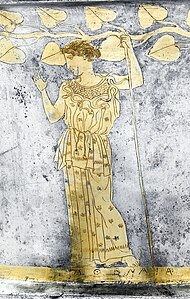
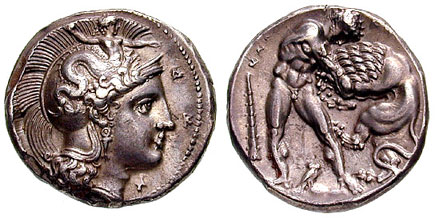
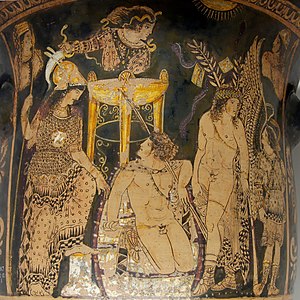
![Аттический чернофигурный эксалептрон рождения Афины из головы Зевса (ок. 570–560 до н.э.) работы художника С.[211]](http://upload.wikimedia.org/wikipedia/commons/thumb/d/d6/Exaleiptron_birth_Athena_Louvre_CA616_n2.jpg/334px-Exaleiptron_birth_Athena_Louvre_CA616_n2.jpg)


![Рельеф Скорбящей Афины (ок. 470–460 до н.э.)[214][211]](http://upload.wikimedia.org/wikipedia/commons/thumb/1/14/Acropole_Mus%C3%A9e_Ath%C3%A9na_pensante.JPG/225px-Acropole_Mus%C3%A9e_Ath%C3%A9na_pensante.JPG)

